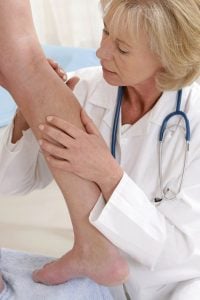Who is at-risk for restless legs syndrome?
Around 1 in 10 of the American population suffer from restless legs syndrome. Restless legs syndrome does not discriminate between men and women. The symptoms may start to present themselves at any age (infants and young children may even be affected). About 2% to 5% of sufferers are severely affected. The majority of those are 40 years of age or older. Are you at-risk for restless legs syndrome?
Restless legs syndrome commonly goes misdiagnosed or unrecognized. A majority of sufferers go ten to twenty years after first noticing symptoms before having the condition properly diagnosed. The good news is that once properly diagnosed, RLS no longer has to interfere with your quality of life. Talk to your doctor right away if you suspect that you have RLS. Proper treatment can often prevent you from suffering any longer.
Personal routines and habits have a huge impact on the severity of restless legs syndrome and other sleeping disorders. In may cases, daily habits are the main cause of the problem. By avoiding these routines and adopting others, your RLS may disappear.
Some simple steps to improve restless leg syndrome
1. Avoid Alcohol At All Cost
If you drink alcohol often and think that it can help you sleep fast then you must be wondering why you must avoid it, right?
Well, it’s because alcohol can help you sleep faster but it can’t help you sleep peacefully.
The sleep you receive after drinking alcohol isn’t restful at all, you will wake up, again and again, and you will feel more disturbance in your legs which will increase the symptoms of your RLS.
Furthermore, after a restless sleep you will feel drowsy in the afternoon which will ruin your sleep at night, so make sure to stay away from it!
2. Plan a Healthy Sleep Schedule
This may not sound very effective but planning a healthy sleep schedule is one of the best ways to decrease RLS symptoms.
There are many things that can help you have better sleep and if you make a schedule of those habits then you will surely sleep peacefully, here are some of those things you can do before going to sleep:
1. Avoid Energy Drinks Before Bed:
Since they are energy drinks they can keep you awake for too long which will cause you difficulty sleeping.
2. Avoid Blue Lights Before Bed:
Blue lights are the lights emitted by screen devices, if you use them before sleeping then they can make it difficult for you to fall asleep so avoid them at least 1 hour before going to bed.
3. Go To Bed At The Same Time Everyday:
Did you know if you go to bed at the same time every day then you can sleep more peacefully? If not then you should try it, since it’s really worth it.
It works because our body has an internal clock that controls our habits, so if you sleep at the same time every day it will already know when it’s time to sleep then it will induce sleep which will help you sleep peacefully without any RLS symptoms.
These steps are not a substitute for professional medical advice. If you suspect that you have RLS, consult with your doctor immediately.
When to look for doctor for restlessness leg syndrome?
Restless legs syndrome (RLS) is a condition characterized by an uncomfortable sensation in the legs, which is usually relieved by movement. The symptoms tend to worsen at night or during periods of rest, making it difficult to sleep. If you experience symptoms of RLS, you should consider seeking medical attention.
You should see a doctor for RLS if the symptoms are interfering with your sleep or daily activities. The doctor will be able to assess your symptoms and help determine the underlying cause of the condition. In some cases, RLS may be a symptom of an underlying medical condition, such as iron deficiency anemia, kidney disease, or diabetes, and treatment of the underlying condition may help alleviate the RLS symptoms.
Additionally, if you are experiencing symptoms of RLS, it is important to rule out any other conditions that may be causing similar symptoms. Your doctor may recommend additional tests or exams to help determine the underlying cause of your symptoms.
Treatment for RLS typically involves lifestyle changes, such as avoiding caffeine and alcohol, regular exercise, and maintaining a regular sleep schedule. In some cases, medication may be prescribed to help alleviate symptoms.
In summary, if you are experiencing symptoms of RLS that are interfering with your sleep or daily activities, it is recommended that you seek medical attention from a healthcare professional to help determine the underlying cause and develop an appropriate treatment plan.
Can diet help in RLS?
Yes, diet can play a role in managing RLS symptoms. Iron deficiency is a common cause of RLS, so increasing iron intake through diet or supplements may help alleviate symptoms. Foods that are high in iron include red meat, poultry, fish, beans, spinach, and fortified cereals. Magnesium deficiency may also contribute to RLS, so consuming magnesium-rich foods such as almonds, spinach, avocado, and whole grains may be beneficial.
Are you at-risk for restless legs syndrome?
Around 10% of the people living in the US have restless legs syndrome (RLS). Of these, 4% to 5% of them demonstrate severe symptoms, affecting their day-to-day life. Additionally:
- It is slightly more prevalent in women than in men.
- Most patients with more severe cases of RLS are 40 years of age or older.
- RLS is rare in children but not unheard of. Around 2% of children do get RLS.
- If you have RLS in your family, you are more likely to get it at a younger age.

